96010-I Logic Model
Tenant Resource Network Program
HUD 96010-I.xls
Tenant Resource Network Program
OMB: 2502-0601
Document [xlsx]
Download: xlsx | pdf
Coversheet
Year1
Year2
Year3
Total
GoalsPriorities
Needs
Services
Outcomes
Tools
Reporting
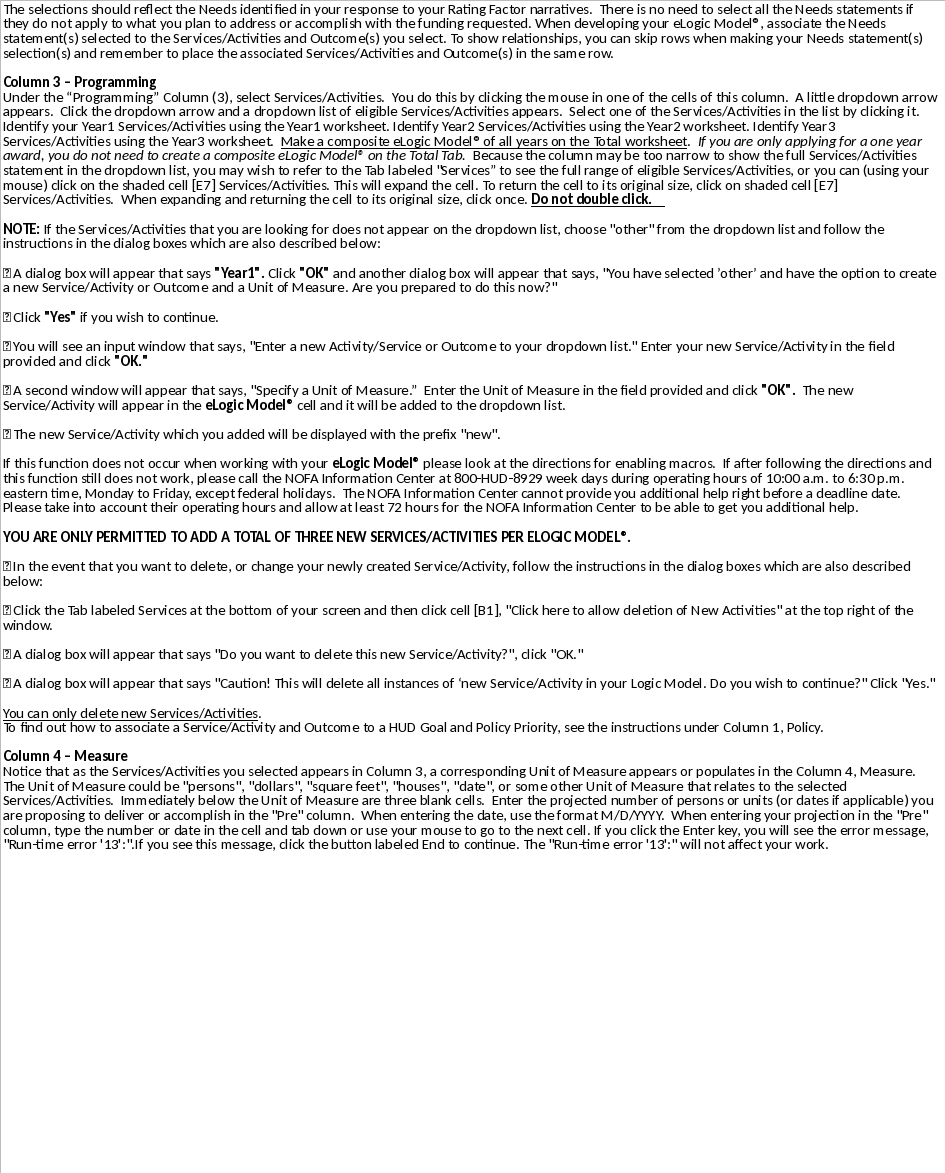



Overview
InstructionsCoversheet
Year1
Year2
Year3
Total
GoalsPriorities
Needs
Services
Outcomes
Tools
Reporting
Sheet 1: Instructions

|
||||||||
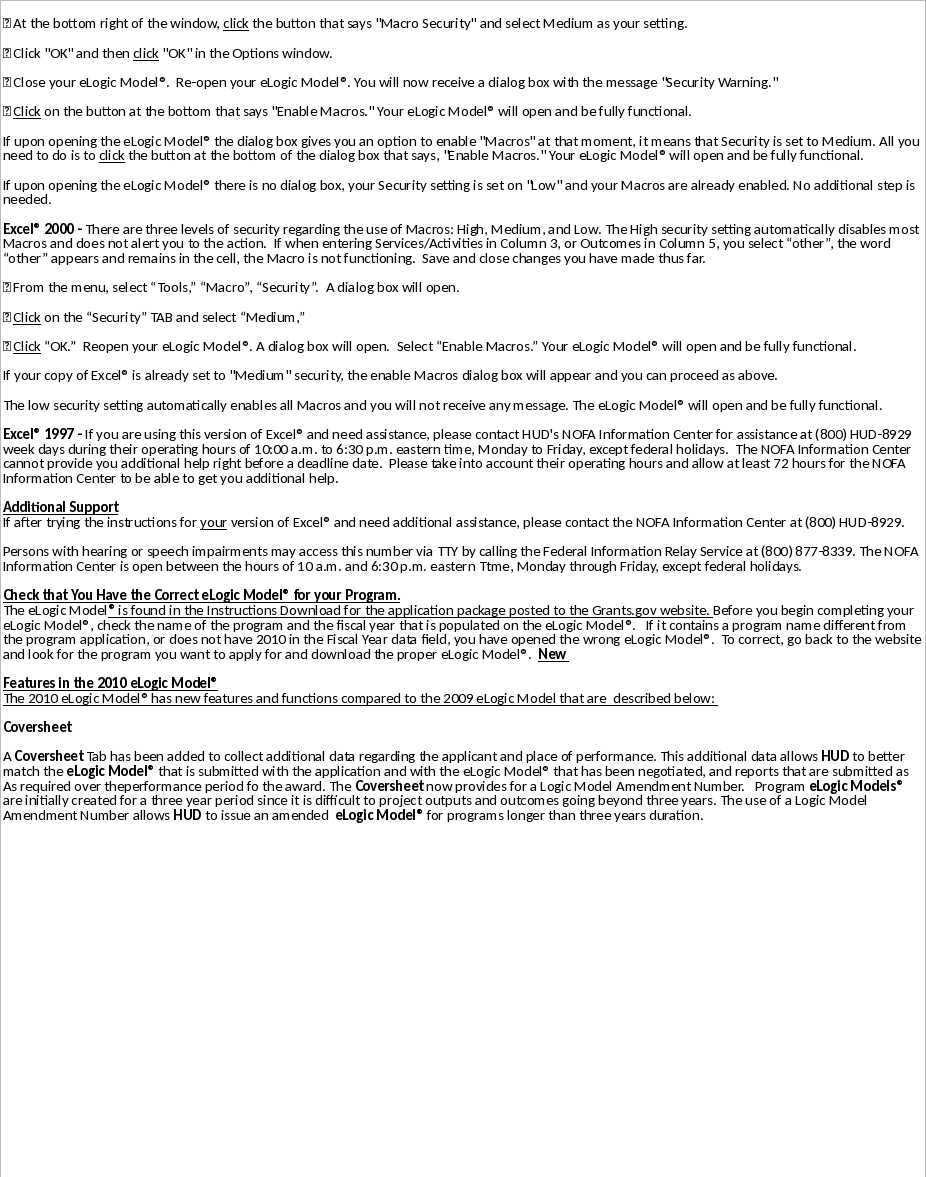
|
||||||||
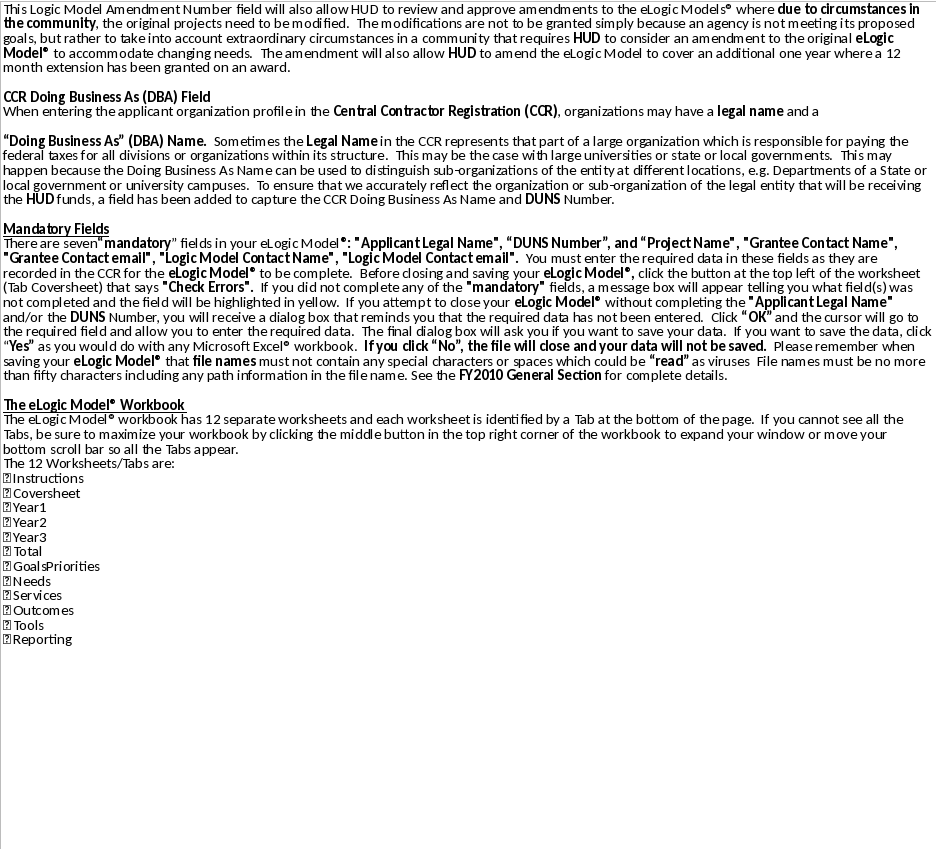
|
||||||||
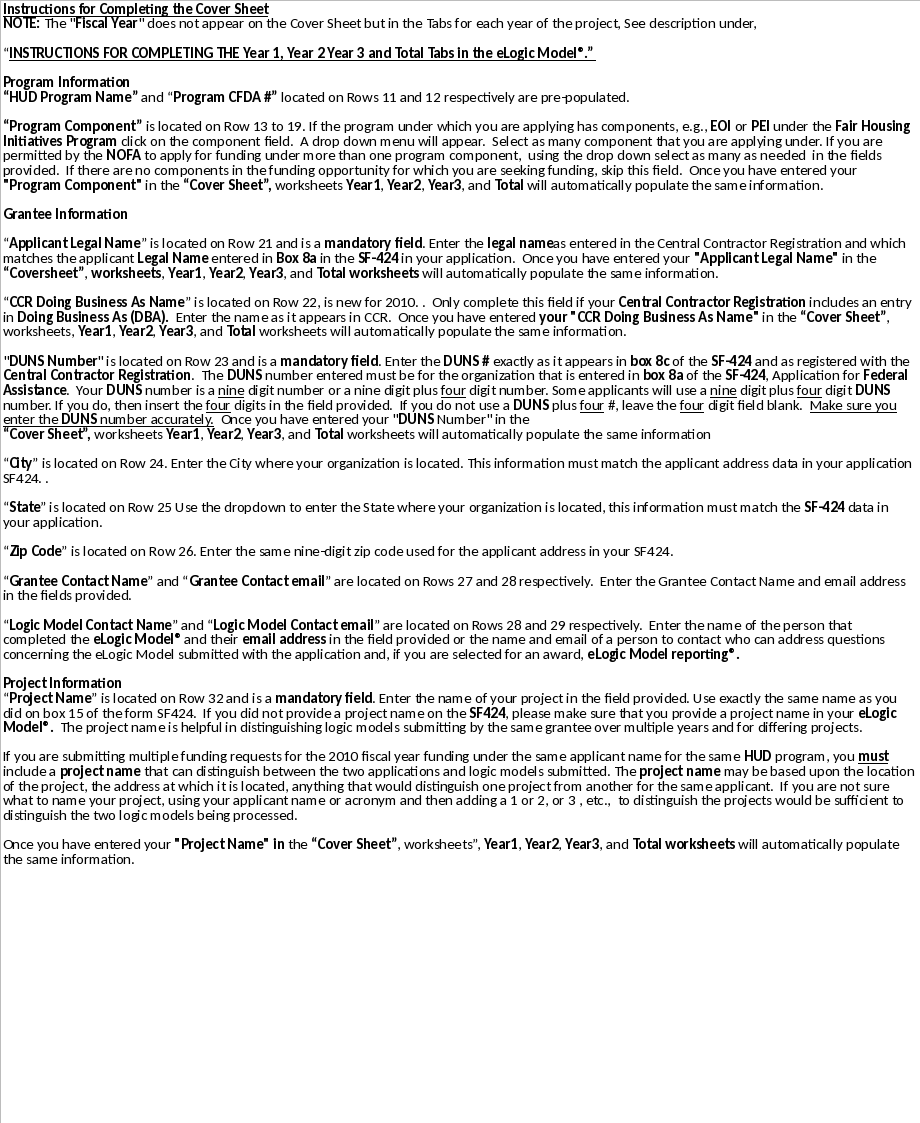
|
||||||||

|
||||||||
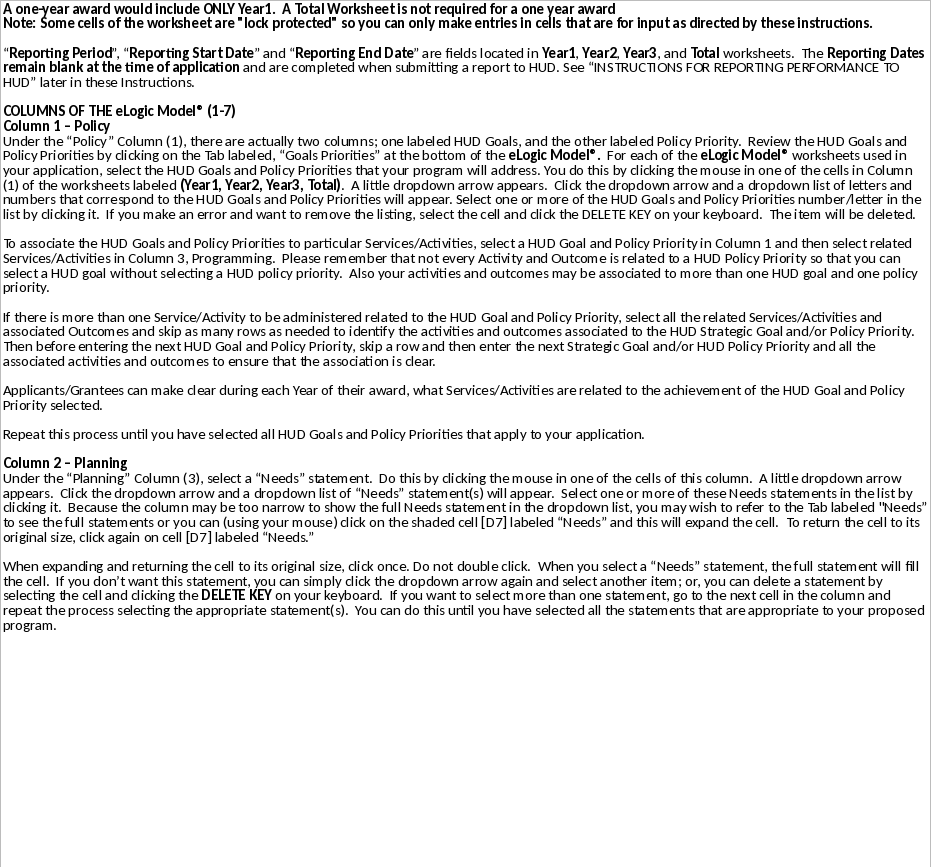
|
||||||||
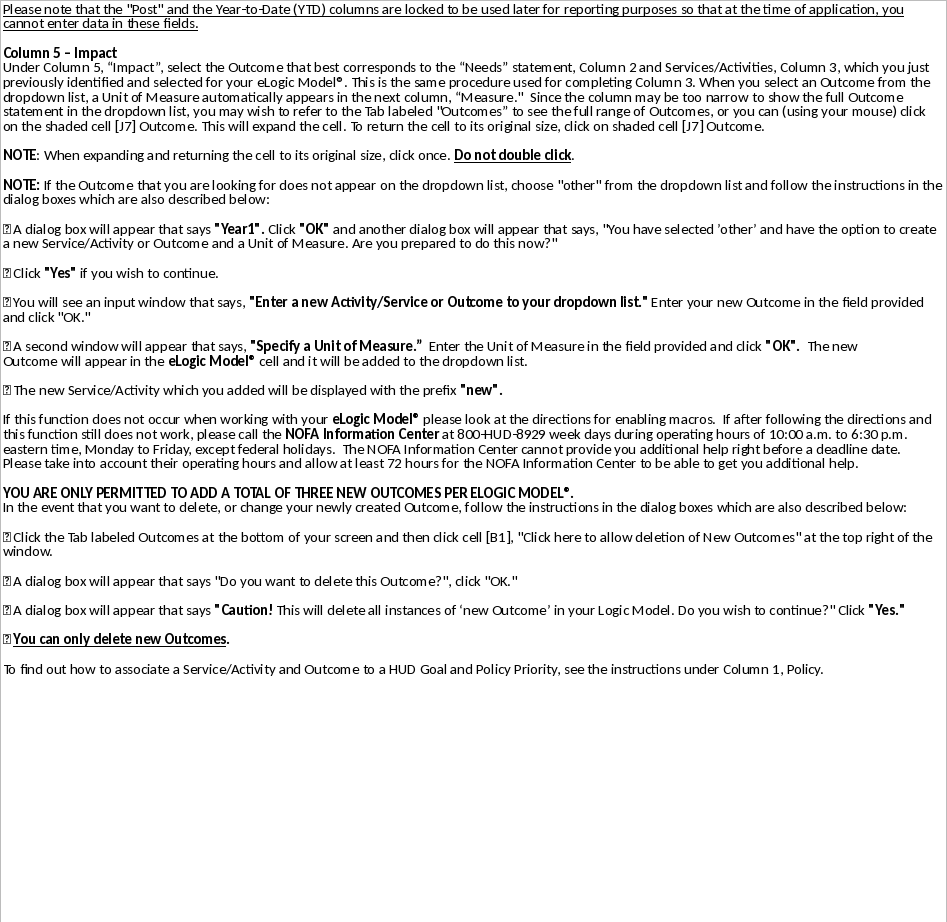
|
||||||||
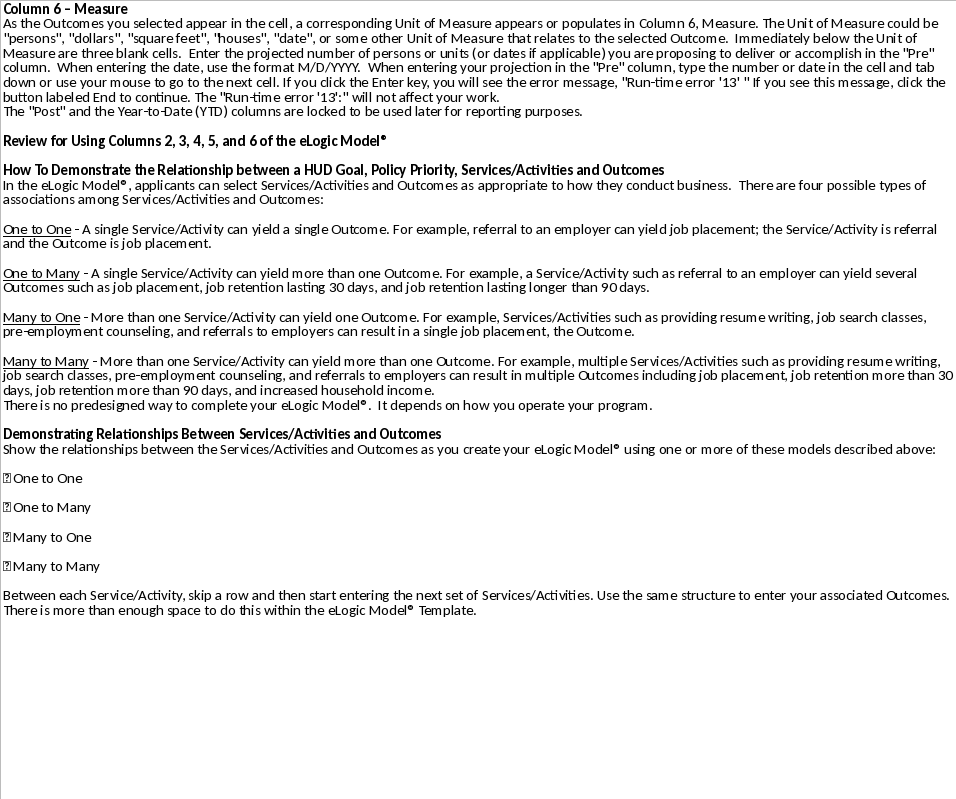
|
||||||||
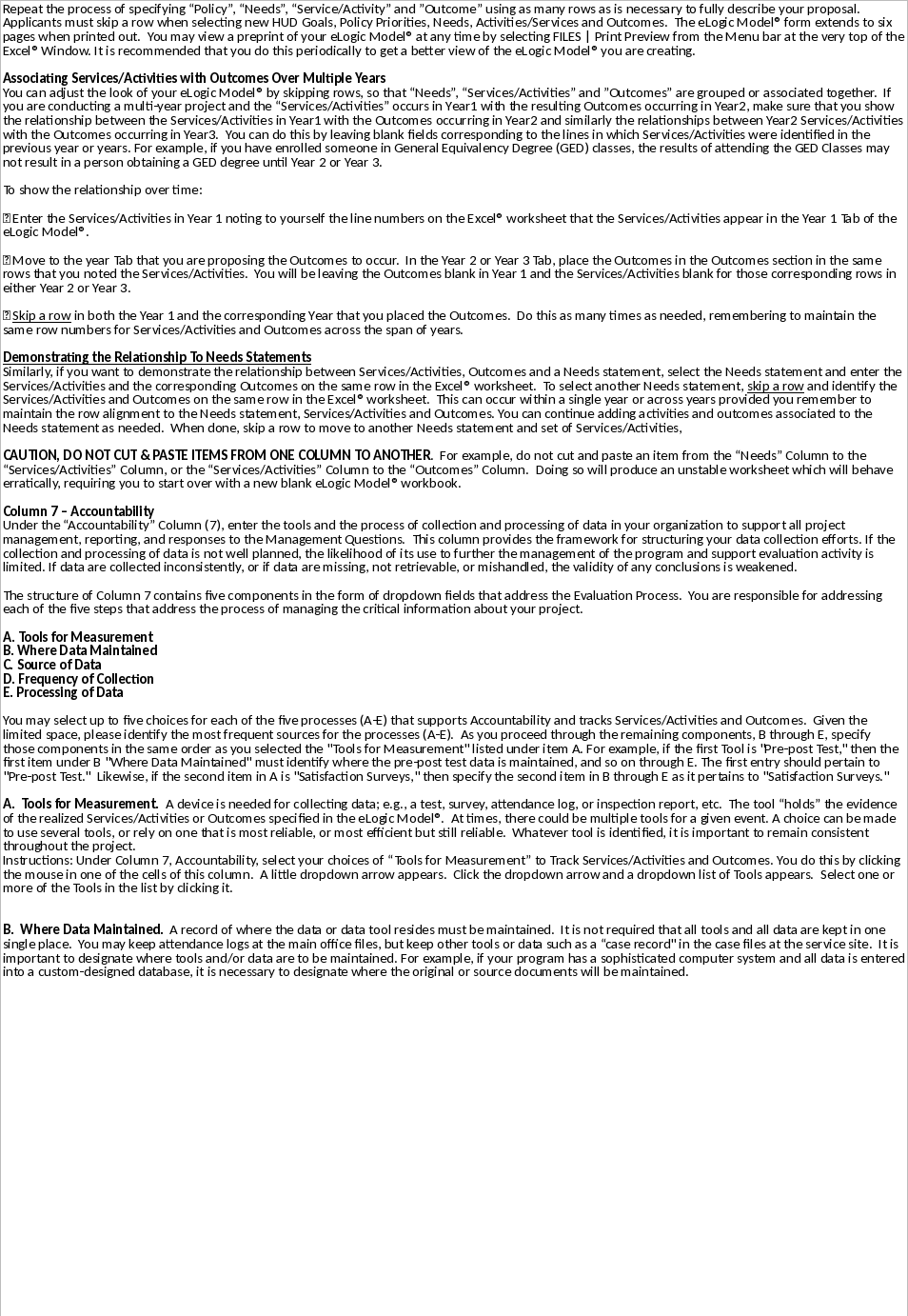
|
||||||||
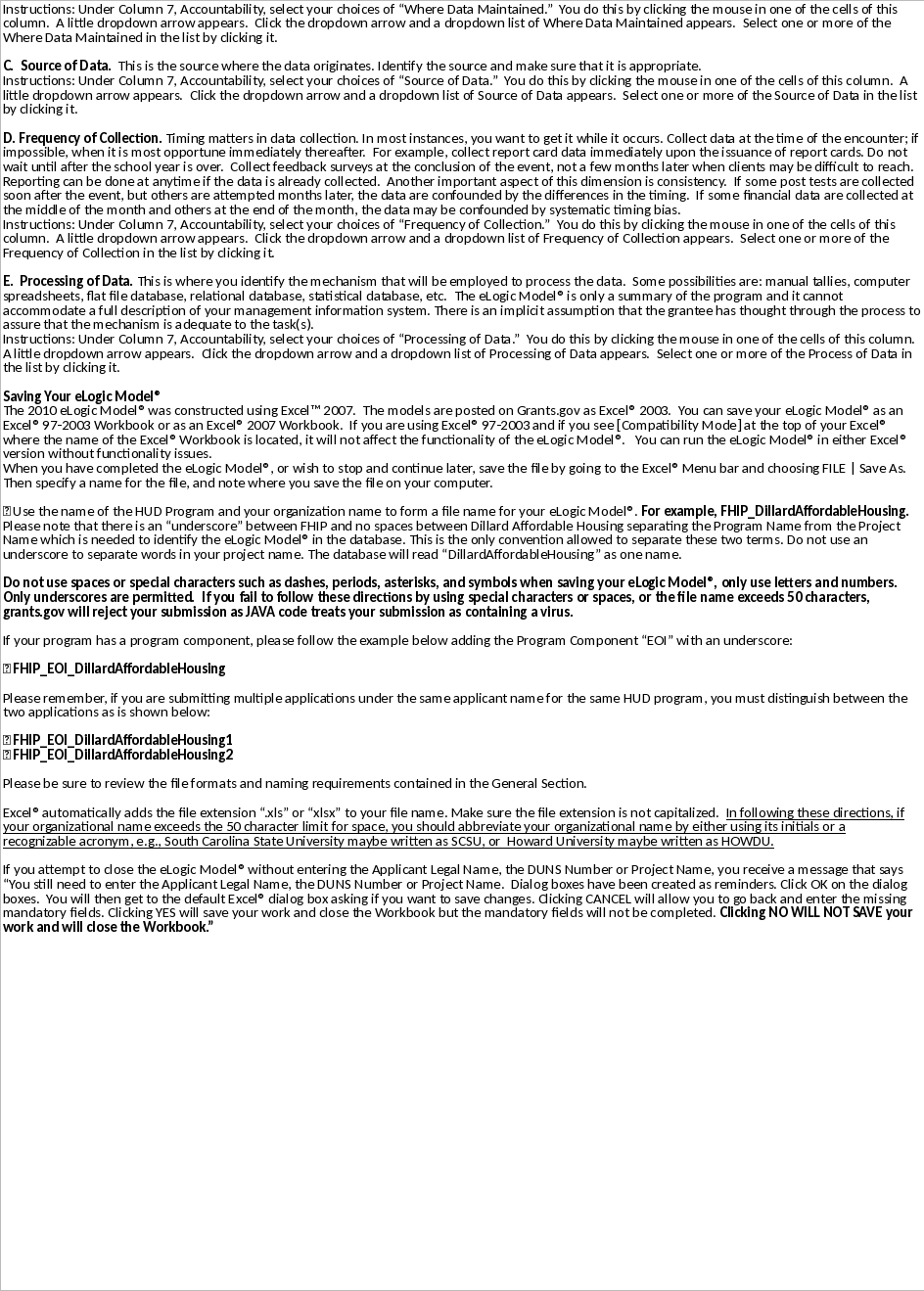
|
||||||||

|
||||||||

|
||||||||
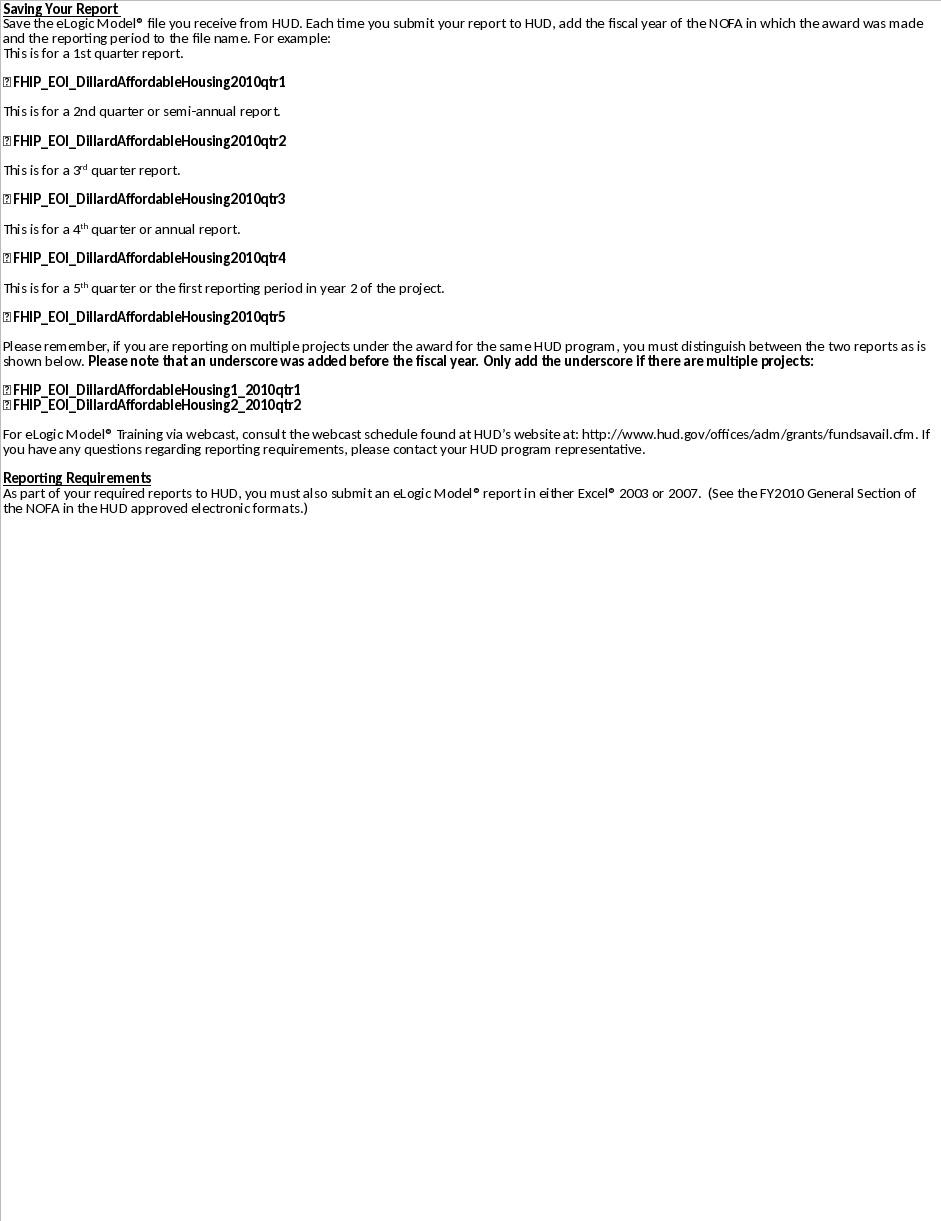
|
||||||||

Sheet 2: Coversheet

Sheet 3: Year1
| eLogic Model® | Year 1 | OMB Approval 2535-0114 exp. 2/28/2011 | ||||||||||||
| Applicant Legal Name | 0 | 
|
||||||||||||
| CCR Doing Business As Name | 0 | |||||||||||||
| HUD Program | Service Coordinators in Multifamily Housing | Reporting Period | ||||||||||||
| Program Component | Reporting Start Date | DUNS No. | 0 | | 0 | |||||||||
| Project Name | 0 | Reporting End Date | 2010 | |||||||||||
| HUD Goals | Policy Priority | Needs | Services/Activities | Measures | Outcomes | Measures | Evaluation Tools | |||||||
| 1 | 2 | 3 | 4 | 5 | 6 | 7 | ||||||||
| Policy | Planning | Programming | Pre | Post | YTD | Impact | Pre | Post | YTD | Accountability | ||||
| #VALUE! | #VALUE! | |||||||||||||
| A. Tools for Measurement | ||||||||||||||
| #VALUE! | #VALUE! | |||||||||||||
| #VALUE! | #VALUE! | |||||||||||||
| #VALUE! | #VALUE! | |||||||||||||
| B. Where Data Maintained | ||||||||||||||
| #VALUE! | #VALUE! | |||||||||||||
| #VALUE! | #VALUE! | |||||||||||||
| #VALUE! | #VALUE! | |||||||||||||
| C. Source of Data | ||||||||||||||
| #VALUE! | #VALUE! | |||||||||||||
| #VALUE! | #VALUE! | |||||||||||||
| #VALUE! | #VALUE! | |||||||||||||
| D. Frequency of Collection | ||||||||||||||
| #VALUE! | #VALUE! | |||||||||||||
| #VALUE! | #VALUE! | |||||||||||||
| #VALUE! | #VALUE! | |||||||||||||
| E. Processing of Data | ||||||||||||||
| #VALUE! | #VALUE! | |||||||||||||
| #VALUE! | #VALUE! | |||||||||||||
| #VALUE! | #VALUE! | |||||||||||||
| #VALUE! | #VALUE! | |||||||||||||
| #VALUE! | #VALUE! | |||||||||||||
| #VALUE! | #VALUE! | |||||||||||||
| #VALUE! | #VALUE! | |||||||||||||
| #VALUE! | #VALUE! | |||||||||||||
| #VALUE! | #VALUE! | |||||||||||||
| #VALUE! | #VALUE! | |||||||||||||
| #VALUE! | #VALUE! | |||||||||||||
| #VALUE! | #VALUE! | |||||||||||||
| #VALUE! | #VALUE! | |||||||||||||
| #VALUE! | #VALUE! | |||||||||||||
| #VALUE! | #VALUE! | |||||||||||||
| #VALUE! | #VALUE! | |||||||||||||
| #VALUE! | #VALUE! | |||||||||||||
| #VALUE! | #VALUE! | |||||||||||||
| #VALUE! | #VALUE! | |||||||||||||
| #VALUE! | #VALUE! | |||||||||||||
| #VALUE! | #VALUE! | |||||||||||||
| #VALUE! | #VALUE! | |||||||||||||
| #VALUE! | #VALUE! | |||||||||||||
| #VALUE! | #VALUE! | |||||||||||||
| #VALUE! | #VALUE! | |||||||||||||
| #VALUE! | #VALUE! | |||||||||||||
| #VALUE! | #VALUE! | |||||||||||||
| #VALUE! | #VALUE! | |||||||||||||
| #VALUE! | #VALUE! | |||||||||||||
| #VALUE! | #VALUE! | |||||||||||||
| #VALUE! | #VALUE! | |||||||||||||
| #VALUE! | #VALUE! | |||||||||||||
| #VALUE! | #VALUE! | |||||||||||||
| #VALUE! | #VALUE! | |||||||||||||
| #VALUE! | #VALUE! | |||||||||||||
| #VALUE! | #VALUE! | |||||||||||||
| #VALUE! | #VALUE! | |||||||||||||
| #VALUE! | #VALUE! | Program Component | ||||||||||||
| 0 | ||||||||||||||
| #VALUE! | #VALUE! | 0 | ||||||||||||
| 0 | ||||||||||||||
| #VALUE! | #VALUE! | 0 | ||||||||||||
| 0 | ||||||||||||||
| #VALUE! | #VALUE! | 0 | ||||||||||||
| #VALUE! | #VALUE! | |||||||||||||
| #VALUE! | #VALUE! | |||||||||||||
| #VALUE! | #VALUE! | |||||||||||||
| #VALUE! | #VALUE! | |||||||||||||
| #VALUE! | #VALUE! | |||||||||||||
| #VALUE! | #VALUE! | |||||||||||||
| #VALUE! | #VALUE! | |||||||||||||
| #VALUE! | #VALUE! | |||||||||||||
| #VALUE! | #VALUE! | |||||||||||||
| #VALUE! | #VALUE! | |||||||||||||
| #VALUE! | #VALUE! | |||||||||||||
| #VALUE! | #VALUE! | |||||||||||||
| #VALUE! | #VALUE! | |||||||||||||
| #VALUE! | #VALUE! | |||||||||||||
| #VALUE! | #VALUE! | |||||||||||||
| #VALUE! | #VALUE! | |||||||||||||
| #VALUE! | #VALUE! | |||||||||||||
| #VALUE! | #VALUE! | |||||||||||||
| #VALUE! | #VALUE! | |||||||||||||
| #VALUE! | #VALUE! | |||||||||||||
| #VALUE! | #VALUE! | |||||||||||||
| #VALUE! | #VALUE! | |||||||||||||
| #VALUE! | #VALUE! | |||||||||||||
| #VALUE! | #VALUE! | |||||||||||||
| #VALUE! | #VALUE! | |||||||||||||
| #VALUE! | #VALUE! | |||||||||||||
| #VALUE! | #VALUE! | |||||||||||||
| #VALUE! | #VALUE! | |||||||||||||
| #VALUE! | #VALUE! | |||||||||||||
| #VALUE! | #VALUE! | |||||||||||||
| #VALUE! | #VALUE! | |||||||||||||
| #VALUE! | #VALUE! | |||||||||||||
| #VALUE! | #VALUE! | |||||||||||||
| #VALUE! | #VALUE! | |||||||||||||
| #VALUE! | #VALUE! | |||||||||||||
| #VALUE! | #VALUE! | |||||||||||||
| #VALUE! | #VALUE! | |||||||||||||
| #VALUE! | #VALUE! | |||||||||||||
| #VALUE! | #VALUE! | |||||||||||||
| #VALUE! | #VALUE! | |||||||||||||
| #VALUE! | #VALUE! | |||||||||||||
| #VALUE! | #VALUE! | |||||||||||||
| #VALUE! | #VALUE! | |||||||||||||
| #VALUE! | #VALUE! | |||||||||||||
| #VALUE! | #VALUE! | |||||||||||||
| #VALUE! | #VALUE! | |||||||||||||
| #VALUE! | #VALUE! | |||||||||||||
| #VALUE! | #VALUE! | |||||||||||||
| #VALUE! | #VALUE! | |||||||||||||
| #VALUE! | #VALUE! | |||||||||||||
| #VALUE! | #VALUE! | |||||||||||||
| #VALUE! | #VALUE! | |||||||||||||
| #VALUE! | #VALUE! | |||||||||||||
| #VALUE! | #VALUE! | |||||||||||||
Sheet 4: Year2
| eLogic Model® | Year 2 | OMB Approval 2535-0114 exp. 2/28/2011 | |||||||||||
| Applicant Legal Name | 0 | ||||||||||||
| CCR Doing Business As Name | 0 | ||||||||||||
| HUD Program | Service Coordinators in Multifamily Housing | Reporting Period | |||||||||||
| Program Component | Reporting Start Date | DUNS No. | 0 | | 0 | ||||||||
| Project Name | 0 | Reporting End Date | 2010 | ||||||||||
| HUD Goals | Policy Priority | Needs | Services/Activities | Measures | Outcomes | Measures | Evaluation Tools | ||||||
| 1 | 2 | 3 | 4 | 5 | 6 | 7 | |||||||
| Policy | Planning | Programming | Pre | Post | YTD | Impact | Pre | Post | YTD | Accountability | |||
| #VALUE! | #VALUE! | ||||||||||||
| A. Tools for Measurement | |||||||||||||
| #VALUE! | #VALUE! | ||||||||||||
| #VALUE! | #VALUE! | ||||||||||||
| #VALUE! | #VALUE! | ||||||||||||
| B. Where Data Maintained | |||||||||||||
| #VALUE! | #VALUE! | ||||||||||||
| #VALUE! | #VALUE! | ||||||||||||
| #VALUE! | #VALUE! | ||||||||||||
| C. Source of Data | |||||||||||||
| #VALUE! | #VALUE! | ||||||||||||
| #VALUE! | #VALUE! | ||||||||||||
| #VALUE! | #VALUE! | ||||||||||||
| D. Frequency of Collection | |||||||||||||
| #VALUE! | #VALUE! | ||||||||||||
| #VALUE! | #VALUE! | ||||||||||||
| #VALUE! | #VALUE! | ||||||||||||
| E. Processing of Data | |||||||||||||
| #VALUE! | #VALUE! | ||||||||||||
| #VALUE! | #VALUE! | ||||||||||||
| #VALUE! | #VALUE! | ||||||||||||
| #VALUE! | #VALUE! | ||||||||||||
| #VALUE! | #VALUE! | ||||||||||||
| #VALUE! | #VALUE! | ||||||||||||
| #VALUE! | #VALUE! | ||||||||||||
| #VALUE! | #VALUE! | ||||||||||||
| #VALUE! | #VALUE! | ||||||||||||
| #VALUE! | #VALUE! | ||||||||||||
| #VALUE! | #VALUE! | ||||||||||||
| #VALUE! | #VALUE! | ||||||||||||
| #VALUE! | #VALUE! | ||||||||||||
| #VALUE! | #VALUE! | ||||||||||||
| #VALUE! | #VALUE! | ||||||||||||
| #VALUE! | #VALUE! | ||||||||||||
| #VALUE! | #VALUE! | ||||||||||||
| #VALUE! | #VALUE! | ||||||||||||
| #VALUE! | #VALUE! | ||||||||||||
| #VALUE! | #VALUE! | ||||||||||||
| #VALUE! | #VALUE! | ||||||||||||
| #VALUE! | #VALUE! | ||||||||||||
| #VALUE! | #VALUE! | ||||||||||||
| #VALUE! | #VALUE! | ||||||||||||
| #VALUE! | #VALUE! | ||||||||||||
| #VALUE! | #VALUE! | ||||||||||||
| #VALUE! | #VALUE! | ||||||||||||
| #VALUE! | #VALUE! | ||||||||||||
| #VALUE! | #VALUE! | ||||||||||||
| #VALUE! | #VALUE! | ||||||||||||
| #VALUE! | #VALUE! | ||||||||||||
| #VALUE! | #VALUE! | ||||||||||||
| #VALUE! | #VALUE! | ||||||||||||
| #VALUE! | #VALUE! | ||||||||||||
| #VALUE! | #VALUE! | ||||||||||||
| #VALUE! | #VALUE! | ||||||||||||
| #VALUE! | #VALUE! | ||||||||||||
| #VALUE! | #VALUE! | ||||||||||||
| 0 | |||||||||||||
| #VALUE! | #VALUE! | 0 | |||||||||||
| 0 | |||||||||||||
| #VALUE! | #VALUE! | 0 | |||||||||||
| 0 | |||||||||||||
| #VALUE! | #VALUE! | 0 | |||||||||||
| #VALUE! | #VALUE! | ||||||||||||
| #VALUE! | #VALUE! | ||||||||||||
| #VALUE! | #VALUE! | ||||||||||||
| #VALUE! | #VALUE! | ||||||||||||
| #VALUE! | #VALUE! | ||||||||||||
| #VALUE! | #VALUE! | ||||||||||||
| #VALUE! | #VALUE! | ||||||||||||
| #VALUE! | #VALUE! | ||||||||||||
| #VALUE! | #VALUE! | ||||||||||||
| #VALUE! | #VALUE! | ||||||||||||
| #VALUE! | #VALUE! | ||||||||||||
| #VALUE! | #VALUE! | ||||||||||||
| #VALUE! | #VALUE! | ||||||||||||
| #VALUE! | #VALUE! | ||||||||||||
| #VALUE! | #VALUE! | ||||||||||||
| #VALUE! | #VALUE! | ||||||||||||
| #VALUE! | #VALUE! | ||||||||||||
| #VALUE! | #VALUE! | ||||||||||||
| #VALUE! | #VALUE! | ||||||||||||
| #VALUE! | #VALUE! | ||||||||||||
| #VALUE! | #VALUE! | ||||||||||||
| #VALUE! | #VALUE! | ||||||||||||
| #VALUE! | #VALUE! | ||||||||||||
| #VALUE! | #VALUE! | ||||||||||||
| #VALUE! | #VALUE! | ||||||||||||
| #VALUE! | #VALUE! | ||||||||||||
| #VALUE! | #VALUE! | ||||||||||||
| #VALUE! | #VALUE! | ||||||||||||
| #VALUE! | #VALUE! | ||||||||||||
| #VALUE! | #VALUE! | ||||||||||||
| #VALUE! | #VALUE! | ||||||||||||
| #VALUE! | #VALUE! | ||||||||||||
| #VALUE! | #VALUE! | ||||||||||||
| #VALUE! | #VALUE! | ||||||||||||
| #VALUE! | #VALUE! | ||||||||||||
| #VALUE! | #VALUE! | ||||||||||||
| #VALUE! | #VALUE! | ||||||||||||
| #VALUE! | #VALUE! | ||||||||||||
| #VALUE! | #VALUE! | ||||||||||||
| #VALUE! | #VALUE! | ||||||||||||
| #VALUE! | #VALUE! | ||||||||||||
| #VALUE! | #VALUE! | ||||||||||||
| #VALUE! | #VALUE! | ||||||||||||
| #VALUE! | #VALUE! | ||||||||||||
| #VALUE! | #VALUE! | ||||||||||||
| #VALUE! | #VALUE! | ||||||||||||
| #VALUE! | #VALUE! | ||||||||||||
| #VALUE! | #VALUE! | ||||||||||||
| #VALUE! | #VALUE! | ||||||||||||
| #VALUE! | #VALUE! | ||||||||||||
| #VALUE! | #VALUE! | ||||||||||||
| #VALUE! | #VALUE! | ||||||||||||
| #VALUE! | #VALUE! | ||||||||||||
| #VALUE! | #VALUE! | ||||||||||||

Sheet 5: Year3
| eLogic Model® | Year 3 | OMB Approval 2535-0114 exp. 2/28/2011 | |||||||||||
| Applicant Legal Name | 0 | 
|
|||||||||||
| CCR Doing Business As Name | 0 | ||||||||||||
| HUD Program | Service Coordinators in Multifamily Housing | Reporting Period | |||||||||||
| Program Component | Reporting Start Date | DUNS No. | 0 | | 0 | ||||||||
| Project Name | 0 | Reporting End Date | 2010 | ||||||||||
| HUD Goals | Policy Priority | Needs | Services/Activities | Measures | Outcomes | Measures | Evaluation Tools | ||||||
| 1 | 2 | 3 | 4 | 5 | 6 | 7 | |||||||
| Policy | Planning | Programming | Pre | Post | YTD | Impact | Pre | Post | YTD | Accountability | |||
| #VALUE! | #VALUE! | ||||||||||||
| A. Tools for Measurement | |||||||||||||
| #VALUE! | #VALUE! | ||||||||||||
| #VALUE! | #VALUE! | ||||||||||||
| #VALUE! | #VALUE! | ||||||||||||
| B. Where Data Maintained | |||||||||||||
| #VALUE! | #VALUE! | ||||||||||||
| #VALUE! | #VALUE! | ||||||||||||
| #VALUE! | #VALUE! | ||||||||||||
| C. Source of Data | |||||||||||||
| #VALUE! | #VALUE! | ||||||||||||
| #VALUE! | #VALUE! | ||||||||||||
| #VALUE! | #VALUE! | ||||||||||||
| D. Frequency of Collection | |||||||||||||
| #VALUE! | #VALUE! | ||||||||||||
| #VALUE! | #VALUE! | ||||||||||||
| #VALUE! | #VALUE! | ||||||||||||
| E. Processing of Data | |||||||||||||
| #VALUE! | #VALUE! | ||||||||||||
| #VALUE! | #VALUE! | ||||||||||||
| #VALUE! | #VALUE! | ||||||||||||
| #VALUE! | #VALUE! | ||||||||||||
| #VALUE! | #VALUE! | ||||||||||||
| #VALUE! | #VALUE! | ||||||||||||
| #VALUE! | #VALUE! | ||||||||||||
| #VALUE! | #VALUE! | ||||||||||||
| #VALUE! | #VALUE! | ||||||||||||
| #VALUE! | #VALUE! | ||||||||||||
| #VALUE! | #VALUE! | ||||||||||||
| #VALUE! | #VALUE! | ||||||||||||
| #VALUE! | #VALUE! | ||||||||||||
| #VALUE! | #VALUE! | ||||||||||||
| #VALUE! | #VALUE! | ||||||||||||
| #VALUE! | #VALUE! | ||||||||||||
| #VALUE! | #VALUE! | ||||||||||||
| #VALUE! | #VALUE! | ||||||||||||
| #VALUE! | #VALUE! | ||||||||||||
| #VALUE! | #VALUE! | ||||||||||||
| #VALUE! | #VALUE! | ||||||||||||
| #VALUE! | #VALUE! | ||||||||||||
| #VALUE! | #VALUE! | ||||||||||||
| #VALUE! | #VALUE! | ||||||||||||
| #VALUE! | #VALUE! | ||||||||||||
| #VALUE! | #VALUE! | ||||||||||||
| #VALUE! | #VALUE! | ||||||||||||
| #VALUE! | #VALUE! | ||||||||||||
| #VALUE! | #VALUE! | ||||||||||||
| #VALUE! | #VALUE! | ||||||||||||
| #VALUE! | #VALUE! | ||||||||||||
| #VALUE! | #VALUE! | ||||||||||||
| #VALUE! | #VALUE! | ||||||||||||
| #VALUE! | #VALUE! | ||||||||||||
| #VALUE! | #VALUE! | ||||||||||||
| #VALUE! | #VALUE! | ||||||||||||
| #VALUE! | #VALUE! | ||||||||||||
| #VALUE! | #VALUE! | ||||||||||||
| 0 | |||||||||||||
| #VALUE! | #VALUE! | 0 | |||||||||||
| 0 | |||||||||||||
| #VALUE! | #VALUE! | 0 | |||||||||||
| 0 | |||||||||||||
| #VALUE! | #VALUE! | 0 | |||||||||||
| #VALUE! | #VALUE! | ||||||||||||
| #VALUE! | #VALUE! | ||||||||||||
| #VALUE! | #VALUE! | ||||||||||||
| #VALUE! | #VALUE! | ||||||||||||
| #VALUE! | #VALUE! | ||||||||||||
| #VALUE! | #VALUE! | ||||||||||||
| #VALUE! | #VALUE! | ||||||||||||
| #VALUE! | #VALUE! | ||||||||||||
| #VALUE! | #VALUE! | ||||||||||||
| #VALUE! | #VALUE! | ||||||||||||
| #VALUE! | #VALUE! | ||||||||||||
| #VALUE! | #VALUE! | ||||||||||||
| #VALUE! | #VALUE! | ||||||||||||
| #VALUE! | #VALUE! | ||||||||||||
| #VALUE! | #VALUE! | ||||||||||||
| #VALUE! | #VALUE! | ||||||||||||
| #VALUE! | #VALUE! | ||||||||||||
| #VALUE! | #VALUE! | ||||||||||||
| #VALUE! | #VALUE! | ||||||||||||
| #VALUE! | #VALUE! | ||||||||||||
| #VALUE! | #VALUE! | ||||||||||||
| #VALUE! | #VALUE! | ||||||||||||
| #VALUE! | #VALUE! | ||||||||||||
| #VALUE! | #VALUE! | ||||||||||||
| #VALUE! | #VALUE! | ||||||||||||
| #VALUE! | #VALUE! | ||||||||||||
| #VALUE! | #VALUE! | ||||||||||||
| #VALUE! | #VALUE! | ||||||||||||
| #VALUE! | #VALUE! | ||||||||||||
| #VALUE! | #VALUE! | ||||||||||||
| #VALUE! | #VALUE! | ||||||||||||
| #VALUE! | #VALUE! | ||||||||||||
| #VALUE! | #VALUE! | ||||||||||||
| #VALUE! | #VALUE! | ||||||||||||
| #VALUE! | #VALUE! | ||||||||||||
| #VALUE! | #VALUE! | ||||||||||||
| #VALUE! | #VALUE! | ||||||||||||
| #VALUE! | #VALUE! | ||||||||||||
| #VALUE! | #VALUE! | ||||||||||||
| #VALUE! | #VALUE! | ||||||||||||
| #VALUE! | #VALUE! | ||||||||||||
| #VALUE! | #VALUE! | ||||||||||||
| #VALUE! | #VALUE! | ||||||||||||
| #VALUE! | #VALUE! | ||||||||||||
| #VALUE! | #VALUE! | ||||||||||||
| #VALUE! | #VALUE! | ||||||||||||
| #VALUE! | #VALUE! | ||||||||||||
| #VALUE! | #VALUE! | ||||||||||||
| #VALUE! | #VALUE! | ||||||||||||
| #VALUE! | #VALUE! | ||||||||||||
| #VALUE! | #VALUE! | ||||||||||||
| #VALUE! | #VALUE! | ||||||||||||
| #VALUE! | #VALUE! | ||||||||||||
| #VALUE! | #VALUE! | ||||||||||||
Sheet 6: Total
| eLogic Model® | Total | OMB Approval 2535-0114 exp. 2/28/2011 | |||||||||||
| Applicant Legal Name | 0 | 
|
|||||||||||
| CCR Doing Business As Name | 0 | ||||||||||||
| HUD Program | Service Coordinators in Multifamily Housing | Reporting Period | |||||||||||
| Program Component | Reporting Start Date | DUNS No. | 0 | | 0 | ||||||||
| Project Name | 0 | Reporting End Date | 2010 | ||||||||||
| HUD Goals | Policy Priority | Needs | Services/Activities | Measures | Outcomes | Measures | Evaluation Tools | ||||||
| 1 | 2 | 3 | 4 | 5 | 6 | 7 | |||||||
| Policy | Planning | Programming | Pre | Post | YTD | Impact | Pre | Post | YTD | Accountability | |||
| #VALUE! | #VALUE! | ||||||||||||
| A. Tools for Measurement | |||||||||||||
| #VALUE! | #VALUE! | ||||||||||||
| #VALUE! | #VALUE! | ||||||||||||
| #VALUE! | #VALUE! | ||||||||||||
| B. Where Data Maintained | |||||||||||||
| #VALUE! | #VALUE! | ||||||||||||
| #VALUE! | #VALUE! | ||||||||||||
| #VALUE! | #VALUE! | ||||||||||||
| C. Source of Data | |||||||||||||
| #VALUE! | #VALUE! | ||||||||||||
| #VALUE! | #VALUE! | ||||||||||||
| #VALUE! | #VALUE! | ||||||||||||
| D. Frequency of Collection | |||||||||||||
| #VALUE! | #VALUE! | ||||||||||||
| #VALUE! | #VALUE! | ||||||||||||
| #VALUE! | #VALUE! | ||||||||||||
| E. Processing of Data | |||||||||||||
| #VALUE! | #VALUE! | ||||||||||||
| #VALUE! | #VALUE! | ||||||||||||
| #VALUE! | #VALUE! | ||||||||||||
| #VALUE! | #VALUE! | ||||||||||||
| #VALUE! | #VALUE! | ||||||||||||
| #VALUE! | #VALUE! | ||||||||||||
| #VALUE! | #VALUE! | ||||||||||||
| #VALUE! | #VALUE! | ||||||||||||
| #VALUE! | #VALUE! | ||||||||||||
| #VALUE! | #VALUE! | ||||||||||||
| #VALUE! | #VALUE! | ||||||||||||
| #VALUE! | #VALUE! | ||||||||||||
| #VALUE! | #VALUE! | ||||||||||||
| #VALUE! | #VALUE! | ||||||||||||
| #VALUE! | #VALUE! | ||||||||||||
| #VALUE! | #VALUE! | ||||||||||||
| #VALUE! | #VALUE! | ||||||||||||
| #VALUE! | #VALUE! | ||||||||||||
| #VALUE! | #VALUE! | ||||||||||||
| #VALUE! | #VALUE! | ||||||||||||
| #VALUE! | #VALUE! | ||||||||||||
| #VALUE! | #VALUE! | ||||||||||||
| #VALUE! | #VALUE! | ||||||||||||
| #VALUE! | #VALUE! | ||||||||||||
| #VALUE! | #VALUE! | ||||||||||||
| #VALUE! | #VALUE! | ||||||||||||
| #VALUE! | #VALUE! | ||||||||||||
| #VALUE! | #VALUE! | ||||||||||||
| #VALUE! | #VALUE! | ||||||||||||
| #VALUE! | #VALUE! | ||||||||||||
| #VALUE! | #VALUE! | ||||||||||||
| #VALUE! | #VALUE! | ||||||||||||
| #VALUE! | #VALUE! | ||||||||||||
| #VALUE! | #VALUE! | ||||||||||||
| #VALUE! | #VALUE! | ||||||||||||
| #VALUE! | #VALUE! | ||||||||||||
| #VALUE! | #VALUE! | ||||||||||||
| #VALUE! | #VALUE! | ||||||||||||
| 0 | |||||||||||||
| #VALUE! | #VALUE! | 0 | |||||||||||
| 0 | |||||||||||||
| #VALUE! | #VALUE! | 0 | |||||||||||
| 0 | |||||||||||||
| #VALUE! | #VALUE! | 0 | |||||||||||
| #VALUE! | #VALUE! | ||||||||||||
| #VALUE! | #VALUE! | ||||||||||||
| #VALUE! | #VALUE! | ||||||||||||
| #VALUE! | #VALUE! | ||||||||||||
| #VALUE! | #VALUE! | ||||||||||||
| #VALUE! | #VALUE! | ||||||||||||
| #VALUE! | #VALUE! | ||||||||||||
| #VALUE! | #VALUE! | ||||||||||||
| #VALUE! | #VALUE! | ||||||||||||
| #VALUE! | #VALUE! | ||||||||||||
| #VALUE! | #VALUE! | ||||||||||||
| #VALUE! | #VALUE! | ||||||||||||
| #VALUE! | #VALUE! | ||||||||||||
| #VALUE! | #VALUE! | ||||||||||||
| #VALUE! | #VALUE! | ||||||||||||
| #VALUE! | #VALUE! | ||||||||||||
| #VALUE! | #VALUE! | ||||||||||||
| #VALUE! | #VALUE! | ||||||||||||
| #VALUE! | #VALUE! | ||||||||||||
| #VALUE! | #VALUE! | ||||||||||||
| #VALUE! | #VALUE! | ||||||||||||
| #VALUE! | #VALUE! | ||||||||||||
| #VALUE! | #VALUE! | ||||||||||||
| #VALUE! | #VALUE! | ||||||||||||
| #VALUE! | #VALUE! | ||||||||||||
| #VALUE! | #VALUE! | ||||||||||||
| #VALUE! | #VALUE! | ||||||||||||
| #VALUE! | #VALUE! | ||||||||||||
| #VALUE! | #VALUE! | ||||||||||||
| #VALUE! | #VALUE! | ||||||||||||
| #VALUE! | #VALUE! | ||||||||||||
| #VALUE! | #VALUE! | ||||||||||||
| #VALUE! | #VALUE! | ||||||||||||
| #VALUE! | #VALUE! | ||||||||||||
| #VALUE! | #VALUE! | ||||||||||||
| #VALUE! | #VALUE! | ||||||||||||
| #VALUE! | #VALUE! | ||||||||||||
| #VALUE! | #VALUE! | ||||||||||||
| #VALUE! | #VALUE! | ||||||||||||
| #VALUE! | #VALUE! | ||||||||||||
| #VALUE! | #VALUE! | ||||||||||||
| #VALUE! | #VALUE! | ||||||||||||
| #VALUE! | #VALUE! | ||||||||||||
| #VALUE! | #VALUE! | ||||||||||||
| #VALUE! | #VALUE! | ||||||||||||
| #VALUE! | #VALUE! | ||||||||||||
| #VALUE! | #VALUE! | ||||||||||||
| #VALUE! | #VALUE! | ||||||||||||
| #VALUE! | #VALUE! | ||||||||||||
| #VALUE! | #VALUE! | ||||||||||||
| #VALUE! | #VALUE! | ||||||||||||
| #VALUE! | #VALUE! | ||||||||||||
| #VALUE! | #VALUE! | ||||||||||||
| #VALUE! | #VALUE! | ||||||||||||
Sheet 7: GoalsPriorities
| HUD Goals | HUD Priorities | |||
| 1A | Strengthen the Nation’s Housing Market to Bolster the Economy and Protect Consumers (1A) Stem the foreclosure crisis. | 1a | Job Creation/Employment (1a) Improving access to job opportunities through information sharing, coordination with federal, state, and local entities, and other means. | |
| 1B | Strengthen the Nation’s Housing Market to Bolster the Economy and Protect Consumer (1B) Protect and educate consumers when they buy, refinance or rent a home. | 1b | Job Creation/Employment (1b) Increasing access to job training, career services, and work, supports through coordination with federal, state, and local entities. | |
| 1C | Strengthen the Nation’s Housing Market to Bolster the Economy and Protect Consumers (1C) Create financially sustainable homeownership opportunities. | 1c | Job Creation/Employment (1c) Expanding economic and job creation opportunities for low-income residents and creating better transportation access to those jobs and other economic opportunities by partnering with federal and nonprofit agencies, private industry, and planning and economic development organizations and by leveraging federal and private resources. | |
| 1D | Strengthen the Nation’s Housing Market to Bolster the Economy and Protect Consumers (1D) Establish an accountable and sustainable housing finance system. | 2a | Sustainability (2a) Promote and preserve community assets including small businesses, fresh food markets, parks, hospitals, and quality schools by incentivizing comprehensive and inclusive local economic development planning. | |
| 2A | Meet the Need for Quality Affordable Rental Homes (2A) End homelessness and substantially reduce the number of families and individuals with severe housing needs. | 2b | Sustainability (2b) Give consumers more information about the true cost of living by incorporating both housing and transportation costs into measures of affordability. | |
| 2B | Meet the Need for Quality Affordable Rental Homes (2B) Expand the supply of affordable rental homes where most needed. | 2c | Sustainability (2c) Improve residents’ health and safety, particularly that of children and other vulnerable populations, by promoting green and healthy design, construction, rehabilitation, and maintenance of housing and communities. | |
| 2C | Meet the Need for Quality Affordable Rental Homes (2C) Preserve the affordability and improve the quality of federally assisted and private unassisted affordable rental homes. | 2d | Sustainability (2d) Support and promote an energy-efficient, green, and healthy housing market by retrofitting existing housing, supporting energy-efficient new construction, improving home energy labeling, and promoting financing products that reduce the carbon footprint of non-HUD-supported residential buildings. | |
| 2D | Meet the Need for Quality Affordable Rental Homes (2D) Expand families' choices of affordable rental homes located in a broad range of communities. | 2e | Sustainability (2e) Reduce energy consumption and incorporate green building practices in the design and operation of HUD-supported affordable housing. | |
| 3A | Utilize Housing as a Platform for Improving Quality of Life (3A) Utilize HUD assistance to improve educational outcomes and early learning and development. | 2f | Sustainability (2f) Promote coordinated planning, integrating federal resources, and targeting technical assistance at the local, state, and regional levels for sustainable housing and communities. | |
| 3B | Utilize Housing as a Platform for Improving Quality of Life (3B) Utilize HUD assistance to improve health outcomes. | 2g | Sustainability (2g) Promote the design and construction of buildings and communities that are accessible and visitable by people with disabilities. | |
| 3C | Utilize Housing as a Platform for Improving Quality of Life (3C) Utilize HUD assistance to increase economic security and self-sufficiency. | 2h | Sustainability (2h) Promote the use of climate-resilient and disaster-resistant building design, construction and siting. | |
| 3D | Utilize Housing as a Platform for Improving Quality of Life (3D) Utilize HUD assistance to improve housing stability through supportive services for vulnerable populations including the elderly, people with disabilities, homeless people, and those individuals and families at risk of becoming homeless. | 2i | Sustainability (2i) Encourage metropolitan and regional focus in planning and community development. | |
| 3E | Utilize Housing as a Platform for Improving Quality of Life (3E) Utilize HUD assistance to improve public safety. | 3a | Affirmatively Furthering Fair Housing (3a) Regional coordination of affirmatively furthering fair housing plans, including such activities as developing regional analyses of impediments. | |
| 4A | Build Inclusive and Sustainable Communities Free from Discrimination (4A) Catalyze economic development and job creation, while enhancing and preserving community assets. | 3b | Affirmatively Furthering Fair Housing (3b) Regional strategies to reduce racially segregated living patterns and other effects of formely de jure segregated public or assisted housing in metropolitan areas with a year 2000 dissimilarity index of 70 or higher and where the minority population is at least 20,000 or 3 percent of the total population in the Core Based Statistical Area (CBSA), whichever is greater. | |
| 4B | Build Inclusive and Sustainable Communities Free from Discrimination (4B) Promote energy efficient buildings and location efficient communities that are healthy, affordable and diverse. | 3c | Affirmatively Furthering Fair Housing (3c) Decreasing the concentration of poverty and racial segregation in neighborhoods and communities through strategic targeting of resources. | |
| 4C | Build Inclusive and Sustainable Communities Free from Discrimination (4C) Ensure open, diverse, and equitable communities. | 3d | Affirmatively Furthering Fair Housing (3d) Promoting visitability for persons with disabilities in single-family housing. | |
| 4D | Build Inclusive and Sustainable Communities Free from Discrimination (4D) Facilitate disaster preparedness, recovery and resiliency. | 4a | Capacity Building and Knowledge Sharing (4a) Develop, target and deliver technical assistance for increasing affordability in areas experiencing increased rental costs due to development. | |
| 4E | Build Inclusive and Sustainable Communities Free from Discrimination (4E) Build the capacity of local, state and regional public and private organizations. | 4b | Capacity Building and Knowledge Sharing (4b) Strengthen the capacity of state and local partners, including governments and nonprofit organizations, to implement HUD programs, participate in decision making and planning processes, and coordinate on cross-programmatic, place-based approaches through grantmaking and technical assistance. | |
| 5A | Transform the Way HUD Does Business (5A) Build Capacity: Create a flexible and high performing learning organization with a motivated, skilled workforce. | 4c | Capacity Building and Knowledge Sharing (4c) Support knowledge sharing and innovation by disseminating best practices, encouraging peer learning, publishing data analysis and research, and helping to incubate and test new ideas. | |
| 5B | Transform the Way HUD Does Business (5B) Focus on Results: Create an empowered organization that is customer-centered, place based, collaborative, and responsive to employee feedback and focused on results. | 5a | Using Housing as a Platform for Improving Other Outcomes (5a) Increasing access to high quality early learning programs and services through coordination with local programs. | |
| 5C | Transform the Way HUD Does Business (5C) Bureaucracy Busting: Create flexible, modern rules and systems that promote responsiveness, openness and transparency. | 5b | Using Housing as a Platform for Improving Other Outcomes (5b) Providing physical space to co-locate healthcare and wellness services with housing (e.g., on-site health clinics). | |
| 5D | Transform the Way HUD Does Business (5D) Culture Change: Create a healthy, open, flexible work environment that reflects the values of HUD’s mission. | 5c | Using Housing as a Platform for Improving Other Outcomes (5c) Increasing access to public benefits (such as Temporary Assistance to Needy Families and Supplemental Security Income) through outreach and other means. | |
| 5d | Using Housing as a Platform for Improving Other Outcomes (5d) Maintaining or improving the physical environment and design of HUD-assisted residences, giving attention to physical safety and crime prevention. | |||
| 5e | Using Housing as a Platform for Improving Other Outcomes (5e) Providing mobility counseling to increase access to neighborhoods of opportunity. | |||
| 6a | Expand Cross-Cutting Policy Knowledge (6a) Support knowledge sharing and innovation by disseminating best practices, encouraging peer learning, publishing data analysis and research, and helping to incubate and test new ideas. |
Sheet 8: Needs
| CAMP eLogic Model® |
| Column 2 |
| NEEDS |
| There is a lack of service coordinators in multi-family housing to link low-income elderly persons and people with disabilities to the supportive services they need in order to continue living independently. |
Sheet 9: Services
| CAMP eLogic Model® |
Click here to allow deletion of 'New' Activities |
| Column 3 | |
| SERVICES/ACTIVITIES | UNITS |
| Case Management-Assist residents in applying for health benefits-Residents |Residents | Residents |
| Case Management-Assist residents in applying for health benefits-Benefits |Benefits | Benefits |
| Case Management-Coordinate assisted living services |Residents | Residents |
| Case Management-Coordinate educational activities-Residents |Residents | Residents |
| Case Management-Coordinate educational activities-Sessions |Sessions | Sessions |
| Case Management-Coordinate preventive health activities-Residents |Residents | Residents |
| Case Management-Coordinate preventive health activities-Sessions |Sessions | Sessions |
| Case Management-Create supportive services-Residents |Residents | Residents |
| Case Management-Create supportive services-Services |Services | Services |
| Case Management-Help residents build informal support networks - residents |Residents | Residents |
| Case Management-Monitor the activities and services of residents- residents |Residents | Residents |
| Case Management-Set up volunteer programs-Programs |Programs | Programs |
| Case Management-Set up volunteer programs-Volunteers |Volunteers | Volunteers |
| Education-Educate property management staff on aging in place issues-Persons |Persons | Persons |
| Education-Educate property management staff on aging in place issues-Sessions |Sessions | Sessions |
| Education-Educate property management staff on service coordination issues- Persons |Persons | Persons |
| Education-Educate property management staff on service coordination issues- Sessions |Sessions | Sessions |
| Education-Educate residents in obligations of tenancy-Residents |Residents | Residents |
| Education-Educate residents in obligations of tenancy-Sessions |Sessions | Sessions |
| |Residents | Residents |
| Management-Create a directory of community service providers-Number of providers |Providers listed | Providers listed |
| Outreach-Work and consult with tenant organizations |Organizations | Organizations |
| Policy Priority-Capacity Building and Information Sharing-Number of new strategies discussed and implemented to address service needs and increase local capacity. |Strategies | Strategies |
| Policy Priority-Capacity Building and Information Sharing- Participation in, or creation of face-to-face networking meetings with other HUD-funded Service Coordinators and local government aging and/or disability agency staff to address the adequacy of supportive services in your jurisdiction |Annual Meetings | Annual Meetings |
| Policy Priority- Housing as a Platform-Work with community volunteers to create at least one weekly new ongoing exercise activity open to HUD housing residents and the community |Exercise Activities | Exercise Activities |
| Policy Priority- Housing as a Platform-Work with community volunteers to create at least one new ongoing exercise activity open to HUD housing residents and the community- volunteers |Volunteers | Volunteers |
| Policy Priority- Housing as a Platform-Work with local or chapters of national community health organizations to arrange for periodic mobile health screening events open to residents and the neighboring community |Screening Events | Screening Events |
| Policy Priority- Housing as a Platform-Number of partnerships developed with Community Health Clinics to establish medical homes for residents |Partnerships | Partnerships |
| Policy Priority- Housing as a Platform-Number of public benefit programs for which residents apply for as a result of the work of the Service Coordinator - Residents |Residents | Residents |
| Policy Priority-Number of public benefit programs for which residents apply for as a result of the work of the Service Coordinator |Benefit programs | Benefit programs |
| Referral-Refer residents to available supportive services-Residents |Residents | Residents |
| Referral-Refer residents to available supportive services-Services |Services | Services |
| Other |Other |
Sheet 10: Outcomes
| CAMP eLogic Model® |
Click here to allow deletion of 'New' Outcomes |
| Column 5 | |
| OUTCOMES | UNITS |
| Case Management-Assist residents in applying for social service benefits |Residents | Residents |
| Case Management-Assist residents in identifying employment opportunities |Residents | Residents |
| Case Management-Assist residents in obtaining education benefits |Residents | Residents |
| Case Management-Decrease in monthly living expenses-Dollars |Dollars | Dollars |
| Case Management-Decrease in monthly living expenses-Residents |Residents | Residents |
| Case Management-Percentage reduction in eviction actions from previous year-Evictions |Percent Change | Percent Change |
| Case Management-Percentage reduction in eviction actions from previous year-Higher Level Care |Percent Change | Percent Change |
| Case Management-Receipt of healthcare services enabling independent living |Residents | Residents |
| Case Management-Receipt of home management services enabling independent living |Residents | Residents |
| Case Management-Reduction in eviction actions initiated due to lease violations |Evictions | Evictions |
| Case Management-Reduction in move-outs to higher level care |Residents | Residents |
| Case Management-Referrals from directory of community service providers |Referrals | Referrals |
| Case Management-Residents linked with health services |Residents | Residents |
| Case Management-Residents linked with legal services |Residents | Residents |
| Case Management-Residents linked with mental health services |Residents | Residents |
| Case Management-Residents linked with substance abuse services |Residents | Residents |
| Case Management-Residents linked with tax assistance services |Residents | Residents |
| Case Management-Residents linked with transportation services |Residents | Residents |
| Case Management-Residents participating in informal support networks that address issues of morale and social isolation |Residents | Residents |
| Case Management-Residents participating in informal support networks that address recreation issues |Residents | Residents |
| Case Management-Residents participating in informal support networks that address financial issues |Residents | Residents |
| Case Management-Residents participating in informal support networks that address transportation issues |Residents | Residents |
| Case Management-Residents participating in informal support networks that address home management issues |Residents | Residents |
| Case Management-Units receiving services |Units | Units |
| Policy Priority-Capacity Building and Knowledge Sharing-Number of new strategies implemented to address service needs and increase local capacity |Strategies | Strategies |
| Policy Priority- Capacity Building and Knowledge Sharing-Number of new service contacts established to address gaps in services needed by residents |Contacts | Contacts |
| Policy Priority- Capacity Building and Knowledge Sharing-Number of new services provided to residents to address service gaps |Services | Services |
| Policy Priority-Housing as a Platform-Number of exercise activities instituted per week |Activities | Activities |
| Policy Priority-Housing as a Platform-Number of residents attending weekly exercise activities on the property or in the community |Residents | Residents |
| Policy Priority- Housing as a Platform-Number of additional benefits residents receive as a result of the work of the Service Coordinator. |Additional Benefits | Additional Benefits |
| Policy Priority-Housing as a Platform-Number of HUD housing and community residents participating in periodic mobile health screening events |Participants | Participants |
| Policy Priority- Housing as a Platform- Number of mobile health screening events held annually |Events | Events |
| Policy Priority- Housing as a Platform-Number of residents with a medical home |Residents | Residents |
| Other |Other |
Sheet 11: Tools
| CAMP eLogic Model® |
| A. Tools For Measurement |
| Bank accounts |
| Construction log |
| Database |
| Enforcement log |
| Financial aid log |
| Intake log |
| Interviews |
| Mgt. Info. System-automated |
| Mgt. Info. System-manual |
| Outcome scale(s) |
| Phone log |
| Plans |
| Pre-post tests |
| Post tests |
| Program specific form(s) |
| Questionnaire |
| Recruitment log |
| Survey |
| Technical assistance log |
| Time sheets |
| B. Where Data Maintained |
| Agency database |
| Centralized database |
| Individual case records |
| Local precinct |
| Public database |
| School |
| Specialized database |
| Tax Assessor database |
| Training center |
| C. Source of Data |
| Audit report |
| Business licenses |
| Certificate of Occupancy |
| Code violation reports |
| Counseling reports |
| Employment records |
| Engineering reports |
| Environmental reports |
| Escrow accounts |
| Financial reports |
| GED certification/diploma |
| Health records |
| HMIS |
| Inspection results |
| Lease agreements |
| Legal documents |
| Loan monitoring reports |
| Mortgage documents |
| Payment vouchers |
| Permits issued |
| Placements |
| Progress reports |
| Referrals |
| Sale documents |
| Site reports |
| Statistics |
| Tax assessments |
| Testing results |
| Waiting lists |
| Work plan reports |
| D. Frequency of Collection |
| Daily |
| Weekly |
| Monthly |
| Quarterly |
| Biannually |
| Annually |
| Upon incident |
| E. Processing of Data |
| Computer spreadsheets |
| Flat file database |
| Manual tallies |
| Relational database |
| Statistical database |
Sheet 12: Reporting
| Carter-Richmond Methodology | |||||||
| The Management Questions developed for your program are based on the Carter-Richmond Methodology.* A description of the Carter-Richmond Methodology appears in the General Section of the NOFA. | |||||||
| * © The Accountable Agency – How to Evaluate the Effectiveness of Public and Private Programs,” Reginald Carter, ISBN Number 9780978724924 | |||||||

|
|||||||
| Response to Management Questions | Measure | Answer | |||||
| 1 | How many persons are you serving (unduplicated count)? | Persons | |||||
| 2 | What is the total cost to operate case management services? | Dollars | |||||
| 3 | What does it cost per person to offer case management services? | Dollars | |||||
| 4 | How many persons were able to live independently and/or age in place as a result of being connected to services through this program? | Persons | |||||
| 5 | How many persons stabilized or improved their living conditions as a result of being connected to services through this program? | Persons | |||||
| 6 | What is the average estimated dollar value of benefits received by persons assisted by the Service Coordinator? | Dollars | |||||
| 7 | How many persons obtained FTE employment as a result of services? | FTEs | |||||
| 8 | How many persons retained FTE employment as a result of services? | FTEs | |||||
| 9 | How many persons receiving services moved to a higher level of care? | Persons | |||||
| 10 | How many persons receiving services moved to alternative housing? | Persons | |||||
| 11 | How many residents received community-based services through the assistance of a Service Coordinator? | Persons | |||||
| 12 | What was the average number of services referrals provided to residents? | Services Referrals | |||||
| 13 | What was the average value in dollars of referred services provided by other community based organizations? | Dollars | |||||
| 14 | What was the reduction (#) in move-outs to higher level care? | Move-outs | |||||
| 15 | What was the reduction (#) in eviction actions initiated due to lease violations? | Evictions | |||||
| 16 | Identify the top three aging in place issues. Please enter in order of priority. | ||||||
| 16a | Aging in Place Issue #1 | Aging in Place Issue | |||||
| 16b | Aging in Place Issue #2 | Aging in Place Issue | |||||
| 16c | Aging in Place Issue #3 | Aging in Place Issue | |||||
| 17 | Policy Priority- Identify the three top service gaps identified and addressed as a result of the award | ||||||
| 17a | Service gap #1 | Service gap | |||||
| 17b | Service gap #2 | Service gap | |||||
| 17c | Service gap #3 | Service gap | |||||
| 18 | Policy Priority- Identify the three top medical screenings provided to residents: | ||||||
| 18a | Medical screenings #1 | Medical screenings | |||||
| 18b | Medical screenings #2 | Medical screenings | |||||
| 18c | Medical screenings #3 | Medical screenings | |||||
| 19 | Identify up to three issues facing service coordinators, Please enter in order of priority. | ||||||
| 19a | Issues facing service coordinators #1 | Issues facing service coordinators | |||||
| 19b | Issues facing service coordinators #2 | Issues facing service coordinators | |||||
| 19c | Issues facing service coordinators #3 | Issues facing service coordinators | |||||
| 20 | Policy Priority-Identify up to three new strategies that were implemented to address service needs and increase local capacity? | ||||||
| 20a | New strategy implemented #1 | Strategy | |||||
| 20b | New strategy implemented #2 | Strategy | |||||
| 20c | New strategy implemented #3 | Strategy | |||||
| 21 | Policy Priority- Identify up to three additional benefits residents receive as a result of the work of the Service Coordinator? | ||||||
| 21a | Benefit residents receive as a result of the work of the Service Coordinator? #1 | Benefit | |||||
| 21b | Benefit residents receive as a result of the work of the Service Coordinator? #2 | Benefit | |||||
| 21c | Benefit residents receive as a result of the work of the Service Coordinator? #3 | Benefit | |||||
| If you are collecting client level data, identify the number of persons receiving services: | |||||||
| How many persons receiving services are under the age of 6? | Persons | ||||||
| How many persons receiving services are ages 6-17? | Persons | ||||||
| How many persons receiving services are ages 18-30? | Persons | ||||||
| How many persons receiving services are ages 31-50? | Persons | ||||||
| How many persons receiving services are ages 51-61? | Persons | ||||||
| How many persons receiving services are age 62 and older? | Persons | ||||||
| end | |||||||

|
|||||||
| ALABAMA | |||||||
| ALASKA | |||||||
| AMERICAN SAMOA | |||||||
| ARIZONA | |||||||
| ARKANSAS | |||||||
| CALIFORNIA | |||||||
| COLORADO | |||||||
| CONNECTICUT | |||||||
| DELAWARE | |||||||
| DISTRICT OF COLUMBIA | |||||||
| FEDERATED STATES OF MICRONESIA | |||||||
| FLORIDA | |||||||
| GEORGIA | |||||||
| GUAM | |||||||
| HAWAII | |||||||
| IDAHO | |||||||
| ILLINOIS | |||||||
| INDIANA | |||||||
| IOWA | |||||||
| KANSAS | |||||||
| KENTUCKY | |||||||
| LOUISIANA | |||||||
| MAINE | |||||||
| MARSHALL ISLANDS | |||||||
| MARYLAND | |||||||
| MASSACHUSETTS | |||||||
| MICHIGAN | |||||||
| MINNESOTA | |||||||
| MISSISSIPPI | |||||||
| MISSOURI | |||||||
| MONTANA | |||||||
| NEBRASKA | |||||||
| NEVADA | |||||||
| NEW HAMPSHIRE | |||||||
| NEW JERSEY | |||||||
| NEW MEXICO | |||||||
| NEW YORK | |||||||
| NORTH CAROLINA | |||||||
| NORTH DAKOTA | |||||||
| NORTHERN MARIANA ISLANDS | |||||||
| OHIO | |||||||
| OKLAHOMA | |||||||
| OREGON | |||||||
| PALAU | |||||||
| PENNSYLVANIA | |||||||
| PUERTO RICO | |||||||
| RHODE ISLAND | |||||||
| SOUTH CAROLINA | |||||||
| SOUTH DAKOTA | |||||||
| TENNESSEE | |||||||
| TEXAS | |||||||
| UTAH | |||||||
| VERMONT | |||||||
| VIRGIN ISLANDS | |||||||
| VIRGINIA | |||||||
| WASHINGTON | |||||||
| WEST VIRGINIA | |||||||
| WISCONSIN | |||||||
| WYOMING | |||||||

| File Type | application/vnd.ms-excel |
| Author | owner |
| Last Modified By | h18889 |
| File Modified | 2011-05-19 |
| File Created | 2005-11-22 |
© 2025 OMB.report | Privacy Policy